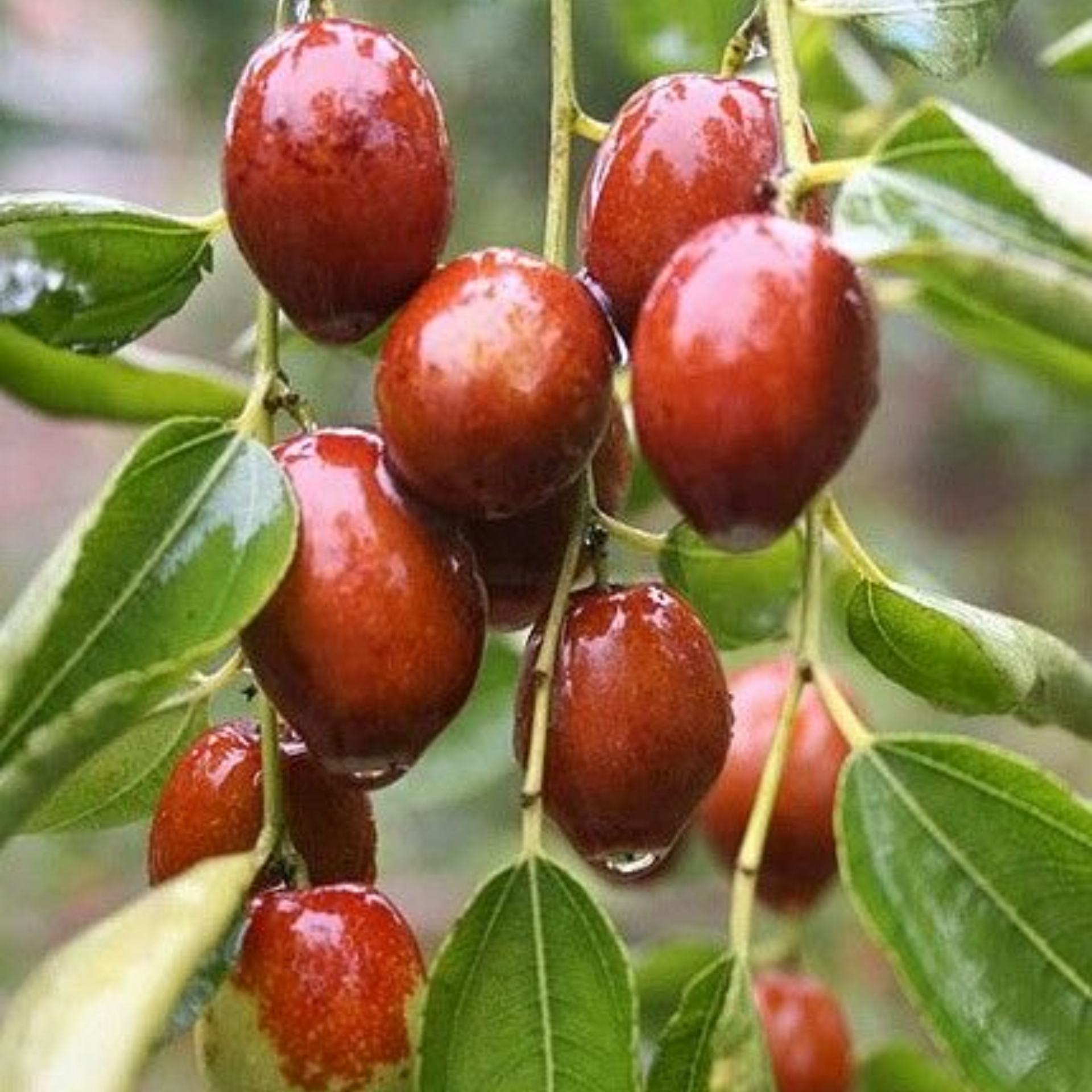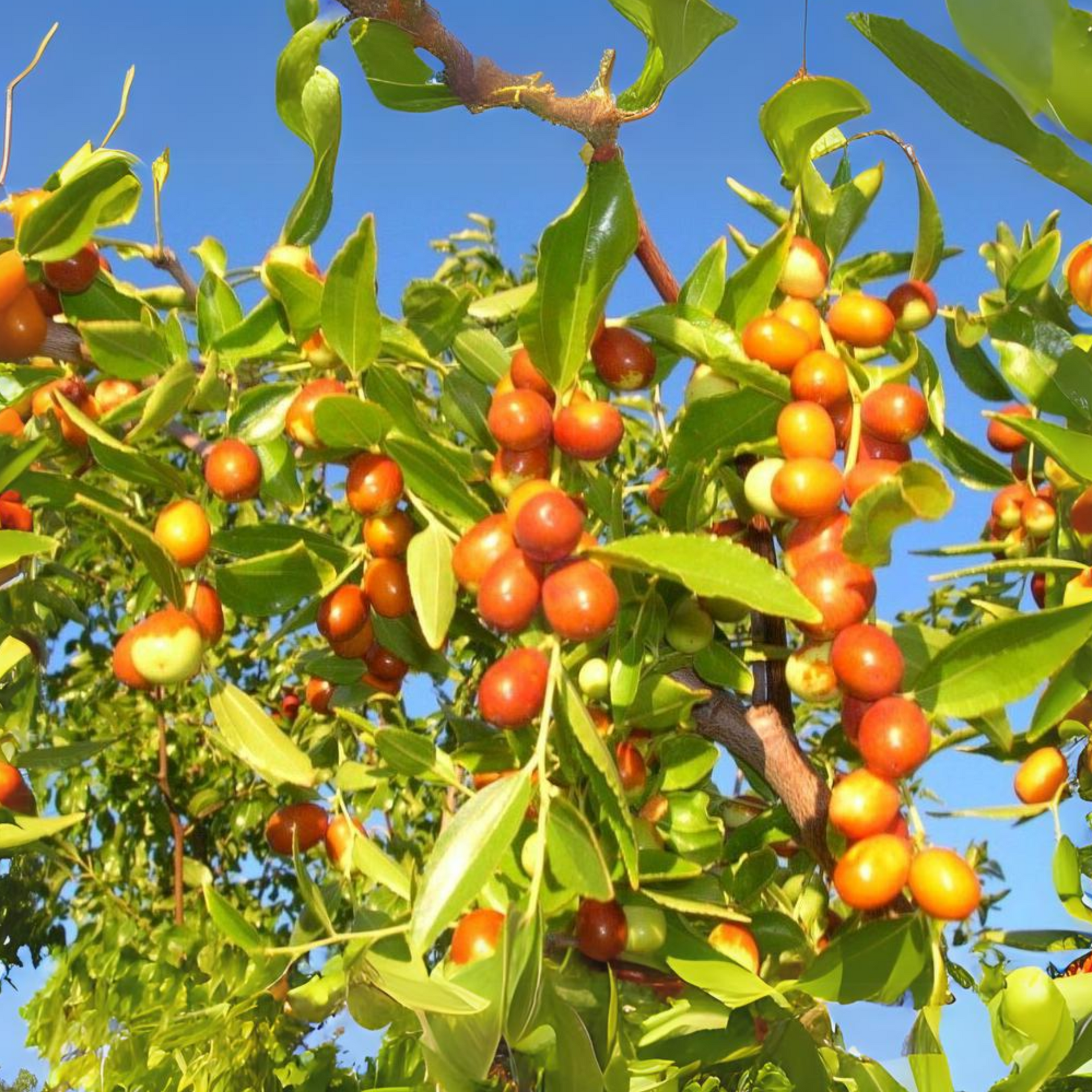


Exclusive Live Sweet Jujube fruit ber Plant Suitable For Bonsai
Guaranteed Safe Checkout
The Ancient Delight: Exploring the
Mystique of Red Jujube Ber Plants
About Red Jujube Ber Plants
- In the realm of fruit-bearing plants, there's one that stands out not just for its delightful taste but also for its fascinating history and myriad health benefits.
- The Red Jujube Ber plant, also known as Ziziphus jujuba, is a marvel in the world of botany, bringing forth not only delicious, ruby-red fruits but also a rich cultural and medicinal legacy.
- In this article, we will embark on a journey to explore the intriguing aspects of the Red Jujube Ber plant.
- The Red Jujube Ber, native to Southern Asia, belongs to the family Rhamnaceae.
- It's a deciduous shrub or small tree that can reach heights of up to 33 feet.
- The leaves are green and ovate, while the flowers are small and yellow, producing a sweet fragrance. However, it's the fruit that steals the show.
The Delightful Fruit
- The Red Jujube Ber fruit, often referred to as the "Chinese date," is a small, oval or round berry, about the size of a plum.
- When ripe, it boasts a brilliant red hue and a sweet, crisp flesh that encapsulates a single seed.
- The flavor is a delightful blend of sweet and slightly tangy, often likened to apples. This fruit is not only tasty but also very nutritious.
Cultural Significance
- The Red Jujube Ber has deep cultural roots, particularly in China and Korea, where it has been cultivated for over 4,000 years.
- In Chinese culture, it is often associated with good luck and prosperity.
- The fruit is a symbol of fertility and is a common gift during weddings.
- In traditional Korean culture, the Red Jujube Ber has been used in rituals and ceremonies.
- It is believed to bring good energy and promote better sleep when consumed.
Health Benefits
Beyond its delightful flavor and cultural significance, the Red Jujube Ber is renowned for its health benefits:
Rich in Nutrients:
These little red fruits are packed with vitamins and minerals, including vitamin C, potassium, and fiber.
Stress Reduction:
They are known for their stress-relieving properties, as they contain compounds that can help calm the nerves and improve sleep quality.
Digestive Aid:
Red Jujube Bers are often used to soothe digestive issues and alleviate symptoms of conditions like acid reflux.
Immune System Support:
Their high vitamin C content helps boost the immune system.
Antioxidant Power:
Red Jujube Bers are rich in antioxidants, which can help combat the effects of free radicals and reduce oxidative stress.
Cultivation
- Cultivating Red Jujube Ber plants requires a warm climate, with well-drained soil and plenty of sunlight.
- They are hardy and drought-resistant once established, making them an attractive option for gardeners in many regions.
- The Red Jujube Ber plant is not just a source of delightful, healthy fruits but a bearer of rich cultural traditions and numerous health benefits.
- Its charming red fruits have graced tables and kitchens for millennia, and its influence continues to spread worldwide as more people discover the magic of this ancient fruit.
- Whether you're interested in its cultural significance, its health benefits, or simply savoring its sweet flavor, the Red Jujube Ber plant offers a fascinating journey of exploration and enjoyment.
Cultivating the Vibrant Red Jujube Berry Plant: A
Comprehensive Guide
The Red Jujube, scientifically known as Ziziphus jujuba, is a remarkable fruit-bearing plant that has been cherished for its delicious and nutritious fruit, the Red Jujube berry. This plant, native to China, has been cultivated for over 4,000 years, and its popularity is now spreading worldwide. Growing Red Jujube berries is not only a delight for the taste buds but also a rewarding experience for gardeners. In this comprehensive guide, we will walk you through the process of successfully cultivating the Red Jujube berry plant in your own garden.
Choosing the Right Location
Selecting the ideal location for your Red Jujube berry plant is crucial for its growth and fruit production.
Here are some key considerations:
Sunlight:
Red Jujube plants thrive in full sun, so choose a spot that receives at least 6-8 hours of direct sunlight each day.
Soil:
Well-draining soil with a slightly acidic to neutral pH (around 6.0 to 7.5) is best. If your soil is clayey or sandy, amending it with organic matter will improve its quality.
Protection from Frost:
Jujube plants are hardy but can be susceptible to frost damage. Plant them in a location that offers some protection from extreme cold.
Planting Red Jujube Berry Trees
When planting Red Jujube berry trees, consider these steps:
Planting Time:
The best time to plant Red Jujube berry trees is in the spring or fall.
Planting Depth:
Dig a hole twice the width of the root ball and twice the depth of the root ball. Place the tree in the hole, making sure the roots are spread out, and fill it with soil.
Spacing:
Space your Red Jujube trees about 10-15 feet apart to allow for proper air circulation and future growth.
Watering:
Ensure the tree receives adequate water during the initial establishment phase.
Pruning and Training
Pruning is crucial to encourage a strong, healthy structure for your Red Jujube tree and promote fruit production. Here's how:
Remove Weak or Diseased Branches:
Prune away any branches that appear weak or diseased. This helps the tree direct its energy to healthy growth.
Thinning:
Thin out the branches to allow for better airflow and sunlight penetration, which reduces the risk of diseases and pests.
Training:
Consider a central leader training system for young trees to establish a strong main trunk.
Watering and Fertilizing
Watering:
Red Jujube trees are drought-tolerant once established but require regular watering during the first few years. To encourage deep root growth, water deeply but infrequently.
Fertilizing:
Apply a balanced fertilizer in the early spring, and consider additional applications in summer if the growth appears slow. To ensure proper dosage, follow the package directions.
Pest and Disease Management
Red Jujube trees are generally resistant to many pests and diseases, but some common issues to watch for include aphids and root rot. Regular inspections and prompt treatment if you notice any problems are key to maintaining a healthy tree.
Harvesting Red Jujube Berries
The Red Jujube berries ripen in late summer to early fall. They are usually ready for harvest when they turn from green to a deep, glossy red. Simply pluck them from the tree when they are ripe. They can be enjoyed fresh, dried, or used in a variety of culinary dishes.
Cultivating Red Jujube berry plants is a delightful journey that rewards gardeners with tasty and nutritious fruits. With the right location, care, and attention to detail, you can enjoy a bountiful harvest of these vibrant red gems in your own garden. Whether you're an experienced gardener or just starting, growing Red Jujube berries can be a fulfilling and fruitful endeavor that connects you with a centuries-old tradition of horticulture and the rich flavors of this remarkable fruit.




